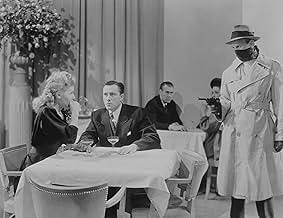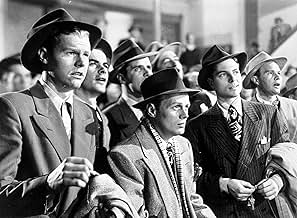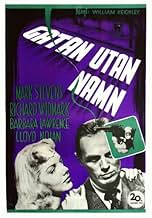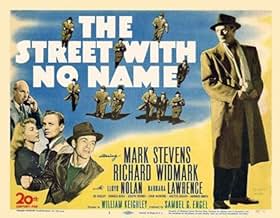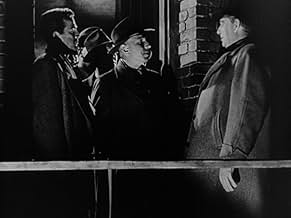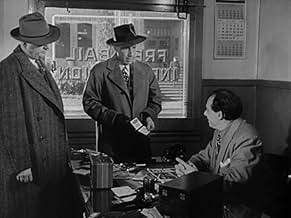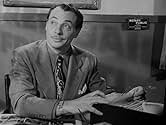Un agent secret du FBI infiltre une bande de gangsters sans pitié, mais sa vie est menacée par un mystérieux informateur qui transmet des informations privilégiées aux truands.Un agent secret du FBI infiltre une bande de gangsters sans pitié, mais sa vie est menacée par un mystérieux informateur qui transmet des informations privilégiées aux truands.Un agent secret du FBI infiltre une bande de gangsters sans pitié, mais sa vie est menacée par un mystérieux informateur qui transmet des informations privilégiées aux truands.
- Réalisation
- Scénario
- Casting principal
- Récompenses
- 2 victoires et 2 nominations au total
- Sparring Partner
- (non crédité)
- Bouncer at Gym
- (non crédité)
- Valentine Laval
- (non crédité)
- Cornerman
- (non crédité)
- Policeman at Arcade
- (non crédité)
- Man at Gym
- (non crédité)
- Prisoner
- (non crédité)
- Desk Sergeant
- (non crédité)
Avis à la une
FBI agent Mark Stevens goes undercover to infiltrate the mob in that cesspool of crime, Center City, USA. In the boxing ring, he attracts the attention, slightly open to inference, of boss Richard Widmark, a dapper ("I like my boys to look sharp") cutthroat with a morbid fear of drafts and sneezes. With the aid of confederate John McIntyre, Stevens reports the gang's plans back to the FBI. Alas, a high-placed informant in the police department reports the FBI's plans back to Widmark.
So the movie boils down to the agent-in-peril story. Keighley tells it cleanly and briskly, eschewing the complexities (both visual and moral) of Anthony Mann's T-Men, released just a few months earlier. It's strongest in the feel for Center City's raffish tenderloin, with its fleabag hotels, pool halls and walk-up gyms. Stevens, McIntyre and Lloyd Nolan (as Stevens' superior) give workmanlike jobs with the rather staid roles scriptwriter Harry Kleiner supplies. His few-frills approach reins in Widmark, too, who's always better when he's unfettered and shooting over the top.
The Street With No Name suffers a bit from staying so resolutely all-guy; thus Barbara Lawrence suffers, too, in an underwritten and inconsequential part as Widmark's abused moll. A little more cool yin might have balanced out all that hot, hard yang.
NOTE: In 1955, Samuel Fuller remade -- and rethought -- this movie, using the same screenwriter and cinematographer (Joe MacDonald, now working in color) as House of Bamboo, set in postwar Tokyo.
*** (out of 4)
A couple gangland killings prompt the FBI to sent agent Gene Cordell (Mark Stevens) into a mob being ran by the hot-tempered Alec Stiles (Richard Widmark). The two strike up a good working relationship but soon informants tip off Stiles and Cordell must try and find a way out before getting killed. This crime/thriller has a lot in common with THE HOUSE ON 92ND STREET, although a lot of issues in that film are corrected here. Thankfully all the introductions and most of the narration is cut out in this film as the screenwriters obviously thought viewers would be smart enough to follow the story without having to have someone tell us what's going on every few minutes. By not having the narration we're greeting with some fine performances as both Stevens and Widmark really nail their characters. Stevens comes off very good as the undercover agent as he perfectly fits the role and comes across smart enough to be able to do everything we see here. It should come as no shock that Widmark steals the film as the snake gangster. There's a scene where he beats up his girlfriend that is so perfectly shot and acted that it really does seem like Widmark is getting a kick out of doing it. He has that certain toughness and coolness that makes his character very cold and he does all of this without a single problem. Ed Begley has a supporting role and does great work with it and we get strong performances by Lloyd Nolan, Donald Buka and Barbara Lawrence. This film has been labeled a "film-noir" but I really didn't see it as this has a lot more in common with the gangster films being released by Warner a decade earlier rather than any of the mysteries or dramas coming from various other studios around this time. The use of shadows will certainly remind folks of noir but that's pretty much it. As a crime film, this here works extremely well because we've got a hero we can care for and a villain that we love to hate. The actual story being told certainly isn't anything too original but it's entertaining enough to work and keep the viewer captivated from start to finish. Keighley's direction is top-notch throughout and he has no problem building up a nice atmosphere that hangs thickly over the film. Fans of Scorsese will also notice a few touches in both GOODFELLAS and THE DEPARTED.
This is a boys film about gangsters. The only woman with any kind of role - Judy (Barbara Lawrence) appears briefly and gets slapped about - I'm not sure her role has any relevance. The story is good and both the main characters, Mark Stevens and Richard Widmark, play their roles convincingly. A slight irritation is the narrator at the beginning - I wished he would just shut up and let the film take its course. Similarly, there are a few overlong sequences of police checking but overall it's a good film. However, it would have all ended differently were it not for an unsung hero, a cab driver (Charles Tannen).
The film (whose title is allegorical) deals with F.B.I. rookie Mark Stevens infiltrating a criminal gang headed by Widmark; the Bureau gave Fox (who produced it) their full co-operation: the studio, in fact, had already made THE HOUSE ON 92ND STREET (1945) in a similar vein and, though THE STREET WITH NO NAME is marked by that earlier title’s innovative semi-documentary style, it actually ties in more with the gangster pictures of the 1930s. Incidentally, director Keighley had been responsible for a number of these over at Warners – including BULLETS OR BALLOTS (1936), which I may well check out presently on the strength of my positive response to this one!; Besides, the hero’s undercover activity and the suspense inherent in such a situation anticipates Raoul Walsh’s WHITE HEAT (1949) – while its scenario, also involving the concurrent presence of a ‘rat’ operating within the Bureau itself, would be replicated nearly 60 years later in Martin Scorsese’s THE DEPARTED (2006)!
At first glance, Stevens looks like an unlikely tough guy but, in retrospect, he acquits himself surprisingly well; Widmark – in his second film – has graduated from sadistic thug to unscrupulous gang boss (memorably introduced, with his face half-hidden behind a handkerchief during a night-club ‘job’, spitting a line at the orchestra conductor: “O.K., Stokowski…dry up!”). The film is also blessed with a terrific supporting cast (including Lloyd Nolan, John McIntire and Ed Begley – all of whom play F.B.I. operatives – Donald Buka being especially noteworthy among the criminals as Widmark’s taciturn but ruthless right-hand man, and only one prominent female figure in Barbara Lawrence as the typically-abused gangster’s moll).
As expected, Joe MacDonald’s shadowy lighting emerges to be an indispensable asset here – rendered even more effective (and realistic) by locations carefully-chosen to fit the desired mood of every sequence. A remarkable outburst of violence at the film’s climax (set inside a warehouse) is equivalent, then, to the icing on the cake.
Le saviez-vous
- AnecdotesThe chase inside the ferry terminal was filmed in the San Pedro Municipal Ferry Terminal in Los Angeles. The building now houses the Los Angeles Maritime Museum.
- GaffesThe wall behind Ed Begley during the Danker interrogation changes from brightly lit to sharply defined shadows of prison bars and back to brightly lit again.
- Citations
Alec Stiles: I haven't seen you around lately.
Gene Cordell: [as George Manly] I've been away.
Alec Stiles: Is that right?
Gene Cordell: Weekend in the country.
Alec Stiles: Courtesy of the city?
Gene Cordell: Something like that.
- ConnexionsFeatured in Los Angeles Plays Itself (2003)
- Bandes originalesBeg Your Pardon
(uncredited)
Written by Francis Craig and Beasley Smith
Performed by Marion Marshall during the opening stick-up
Meilleurs choix
- How long is The Street with No Name?Alimenté par Alexa
Détails
- Date de sortie
- Pays d’origine
- Sites officiels
- Langue
- Aussi connu sous le nom de
- The Street with No Name
- Lieux de tournage
- Municipal Ferry, San Pedro, Californie, États-Unis(As Center City: George Manly walks down street and is tailed to ferry.)
- Société de production
- Voir plus de crédits d'entreprise sur IMDbPro
- Durée1 heure 31 minutes
- Couleur
- Rapport de forme
- 1.33 : 1
Contribuer à cette page



